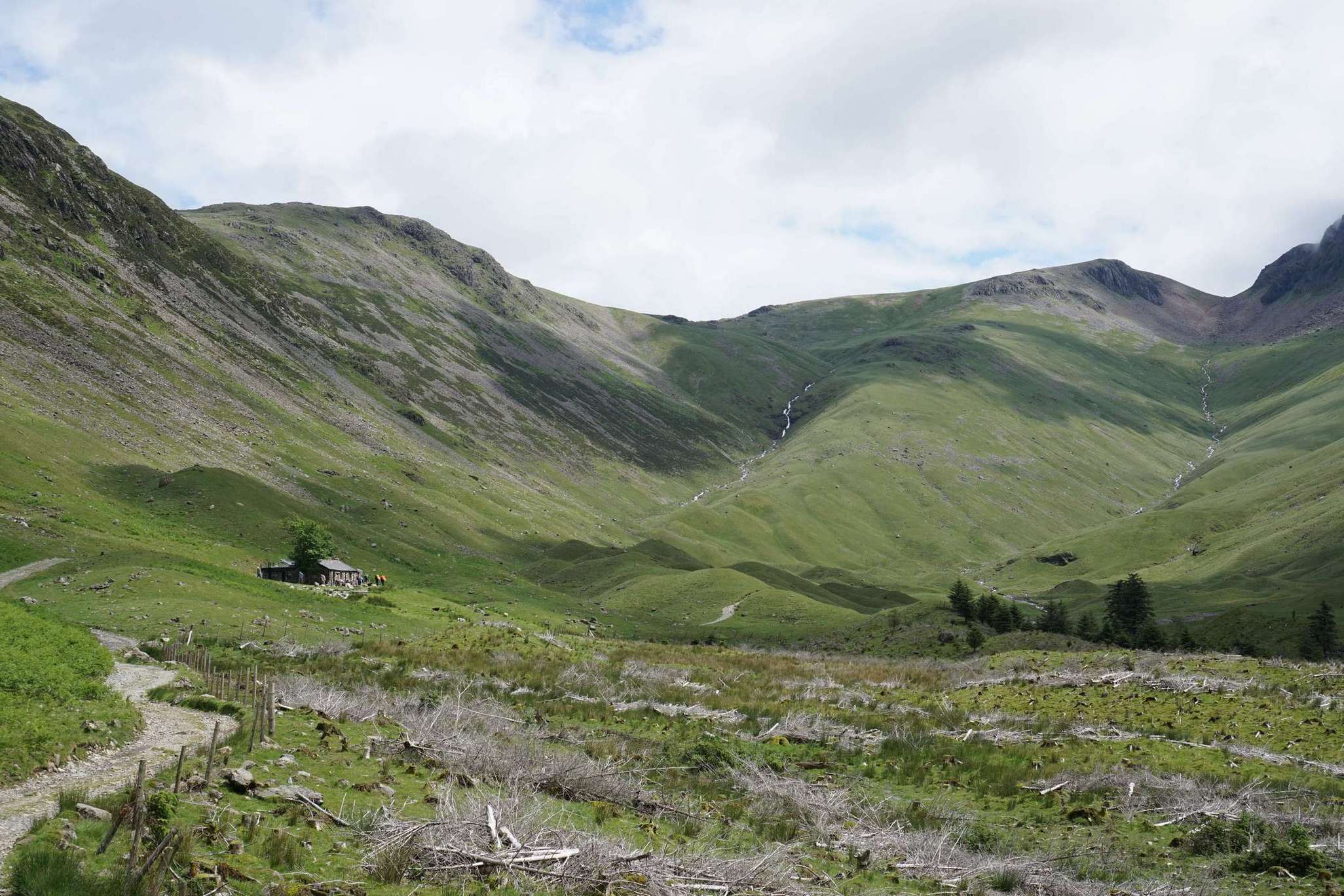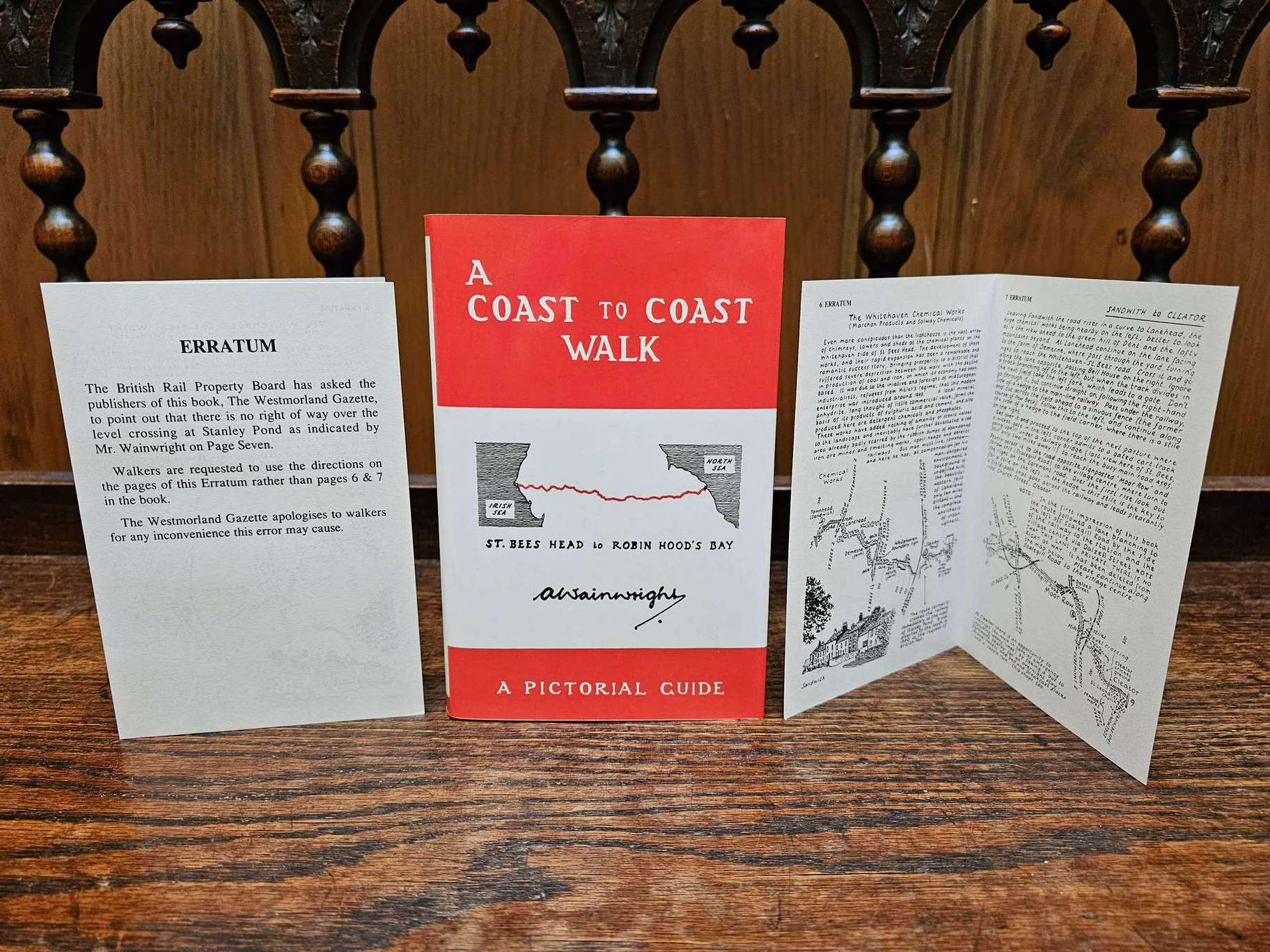Fifty Years of the Coast to Coast Walk
Article by Chris Butterfield
Wainwright’s Coast to Coast Walk, now half a century old, has become one of England’s most popular long-distance paths. It continues to attract thousands of people from home and abroad each year to follow a trail that will forever be part of Wainwright’s legacy.
Inspired by Tom Stephenson’s Pennine Way, the 192-mile Coast to Coast Walk was a brilliant idea by Wainwright to devise a route that crosses three of England’s finest National Parks. The walk starts at St Bees on the Cumbrian coast and ends at Robin Hood’s Bay on the North Yorkshire coast. You couldn’t start any further west or finish any further east, so these terminals were definitive.

The seeds of the idea behind this walk were sown as early as 1970. Wainwright had entered a new and happier chapter in his life and was full of vigour. He had not long since come through the other side of a messy divorce from his first wife, Ruth and had found true love for the first time with Betty McNally.
Wainwright and Betty were married on 10th March 1970, and their honeymoon was spent at the Viking Hotel in York. Wainwright took advantage of this location to begin fieldwork on the North York Moors, which helped further fuel his idea of creating a long-distance walk. The Vale of Mowbray, notable for being the least inspiring section of the trail, proved a challenge, as there was no easy way to circumnavigate it. After the difficult eastern section was mapped out, the rest of the walk would now fall into place.
A Coast to Coast Walk was published in March 1973 and was dedicated to: THE SECOND PERSON (unidentifiable as yet) TO WALK FROM ST. BEES HEAD TO ROBIN HOOD’S BAY.

Wainwright couldn’t drive, so Betty came to the rescue and became his personal chauffeur for most of the location work. This helped the project gain traction, and by the summer of 1972, Wainwright handed the completed manuscript to Harry Firth, the General Printing Manager at the Westmorland Gazette.
Unlike the Pennine Way, Wainwright’s route was unofficial by design. He hoped his walk would encourage and inspire others to create their own walks off the beaten track, away from the crowds. This motive comes across strongly in the introduction and the closing comments of the guidebook.
“…I want to encourage the ambition in others to devise with the aid of maps their own cross-country marathons and not be merely followers of other people’s routes.” A. Wainwright.
However, Wainwright’s good intentions didn’t quite go to plan. He had devised the perfect walk, so very few people veered off the original route and chose to follow in the master’s footsteps.

During the 1980s, Wainwright became hugely popular due to his appearances in several BBC TV series produced by Richard Else and featuring broadcaster Eric Robson. The final TV series aired in September 1989 and focused on the Coast to Coast Walk. Anticipating increased book sales, Andrew Nichol, who succeeded Harry Firth, printed 10,000 additional copies of A Coast to Coast Walk. Astonishingly, all these sold within a month of the series being aired, and Andrew printed an extra 3,000 copies to meet the demand.
Multiple revisions were made to Wainwright’s A Coast to Coast Walk guidebook during the Gazette years between 1973 and 1990. Many of these changes were made due to limited access through private land. One such change was the route beyond Beacon Hill, near Orton. Local farmers eventually withdrew access permission. Campers were causing damage and leaving litter, and farmers had had enough. Wainwright warned readers in 1976, but his plea was ignored, so in 1981, the route was diverted through Orton, adding two miles to the walk.

One of the most notable revisions to the route was in January 1990. Andrew, at the Gazette, received a rather scathing letter. The British Rail Property Board complained about the Coast to Coast Walk going over a level crossing at Stanley Pond, where there was no right of way. British Rail had gone into great detail with their complaint and threatened legal action if the route was not altered. Andrew felt that their initial letter was unnecessarily hostile, and he remembers thinking that a polite phone call explaining their concerns would have sufficed.
Andrew checked the route in person to confirm the danger at the level crossing. He then explained the situation to Wainwright and the changes necessary for the guidebook. The only problem was that Wainwright’s eyesight was failing, so somebody was required to write it on his behalf. Andrew suggested local author and cartographer Chris Jesty, whose handwriting was almost identical to Wainwright’s.

Wainwright agreed and gave the correct wording to Andrew, who immediately contacted Chris, who was delighted to accept the job. One of his ambitions was to revise the Pictorial Guides in the future, and Wainwright kindly gave him his blessing but requested that he not proceed until after his death.
Chris revised two pages in just under twelve hours. The new route diverts south a little to avoid the level crossing. The subtle changes and Chris’s writing blend nicely with Wainwright’s. The guidebook would require a complete reprint, which would take time, so a two-page erratum was printed and placed inside all copies of existing Gazette stock.

Several months after Wainwright’s death in January 1991, the publishing rights were transferred to Michael Joseph. The launch date for the new publisher was April 1992, and it was a huge success. Following the launch, the new publisher pulled the books from Kendal and transferred the printing of the books to Suffolk. This disappointed many, especially Titus Wilson, the Kendal printer, as it was Wainwright’s wish that the books should remain in Kendal, where they’d been since 1955.
Unfortunately, Michael Joseph inherited much baggage as the new Wainwright publisher. Within six months, complaints about the Coast to Coast Walk would land on the latest publisher’s doorstep, which made it into the national press.

Landowners complained that part of the route in the western region involved trespassing. In addition, legions of heavy boots were trampling wildlife, gouging highways through soft peat moorland, and vandalising ancient monuments. The walk had become a victim of its own success, and it was estimated that 20,000 were walking the trail annually. It was not an official walk and, therefore, received little funding.
It was debated about who should pay for the damage, whether substantial changes should be made to the route, or if the book should be scrapped altogether. All fingers were pointing directly at Michael Joseph. The publishing house was against extensive revisions as they viewed Wainwright’s original guidebook as a work of art. They insisted Wainwright, the Estate, and his following wouldn’t want it altered.

The East Cumbria Countryside Project, backed by the Countryside Commission, was alerted to the problem and suggested producing a revised guidebook to run alongside the original. Michael Joseph refused, stating that it wasn’t financially viable.
With pressure mounting on the publisher, a compromise was reached, and some minor unobtrusive route changes were introduced for the next print run. Chris Jesty was given this task, and A Coast to Coast Walk – Revised Edition was published in 1994. Chris was never satisfied with the minor revisions; he hoped to revise the entire book. The additional work was also typeset and didn’t merge with Wainwright’s organic handwriting.

Book sales rapidly declined in 2001, and the suspected cause was the foot and mouth outbreak. Cumbria was the worst affected area, so the Lake District was essentially closed to the public. Michael Joseph ceased publication of the guidebooks in January 2003. It was the first time Wainwright’s work had been out of print, and the copyright returned to Betty Wainwright. Within a month, Frances Lincoln won the bid to republish them and, after ten years away, returned the guidebooks to their rightful home in Kendal. This fantastic news made waves across the media.
The new launch date was April 2003, and book sales exceeded everyone’s expectations. Titus Wilson expanded their premises and employed additional staff to meet the printing demand. Unlike Michael Joseph, Frances Lincoln supported an extensive revision program of all the twelve Pictorial Guides. They hired Chris Jesty, who could now fulfil his dream job, which would consume the next ten years of his life. This project would not affect Wainwright’s original guidebooks, which would remain in print.

Due to rising printing costs, the Pictorial Guides were again pulled from Kendal in 2007 and have never returned. A Coast to Coast Walk – Second Edition was published in 2010. The current A Coast to Coast Walk – Revised Edition was still in print but would eventually be phased out. During this period, The Quarto Group acquired Frances Lincoln, which would go mostly unnoticed by the general public, as they retained the already well-established Frances Lincoln name.
In 2017, Wainwright’s Coast to Coast Walk – Walkers Edition was published. This was essentially an update to the Second Edition. Wainwright’s original narrative was reprinted as A Coast to Coast Walk – Readers Edition. Both titles are still available today.

The success of the Coast to Coast Walk inspired a joint book project between Andrew Nichol and Wainwright in 1989, based on the original guidebook. The working title was Points of Interest on the Coast to Coast Walk. Unfortunately, the project was shelved due to Andrew’s increasing work commitments at the Westmorland Gazette. This story had never been made public before and only came to light when I discussed the walk with Andrew in 2019. He then revealed to me all the photographs of Wainwright taken for the unfinished book.
I asked Andrew why he never went public with this incredible story. He replied, “It was over 30 years ago, and I didn’t think it would be of any interest, especially as the book was never completed.” Shortly after, this story became a leading article in The Times. Andrew was overwhelmed by the public response. “Well, Chris, I never expected this. Perhaps I shouldn’t have underestimated how important this story was. When we began the project, I saw it as simply doing my job. Like many books, if they are dropped, they are forgotten, and we move on. This was no exception.”

This story had me wondering how many more secrets this special walk was hiding, waiting to be unearthed. The BBC filmed the Coast to Coast Walk TV series throughout the spring of 1989. Wainwright and Eric Robson visited St. Mary’s church in the small village of Bolton-on-Swale. On camera, Eric prompted Wainwright to sign the visitors’ book at the church entrance. This was over 34 years ago, and I wondered if the book still existed. It was a long shot, but I contacted the church. Unfortunately, nobody had heard of such a book, but they kindly agreed to check the church vault.
Two weeks later, I received a phone call from Rev Mary Williams, and to my complete surprise, she said that she had found it hidden in the vault. I couldn’t believe it. Nobody at the church knew about it, but they were delighted that such a treasure had been hidden safely for all these years. I knew this book was something Andrew had to see.

My wife Priscilla and I planned a short break to the East Yorkshire Coast during the summer of 2023 and invited Andrew along. It was the perfect opportunity to see the book but to keep it as a surprise for Andrew. I explained to Mary about our visit to several key locations on the Coast to Coast Walk. Visiting the church to see the book would be a wonderful experience, and Mary was delighted to welcome us all.
On the final day of our break, we visited the beautiful St Mary’s church. It was encouraging to see several Coast to Coast Walkers passing through the churchyard heading for Robin Hood’s Bay. Mary greeted us and introduced the church team before revealing the long-lost visitor book. Wainwright’s recognisable handwriting looked as fresh as though it had been written yesterday. It was an emotional moment for Andrew, and he appreciated everything the church had done.



This trip highlighted the walk’s influence across England. Since its initial publication in 1973, A Coast to Coast Walk has maintained its popularity. There are several reasons behind its enduring appeal. It is not just a guidebook; it’s an invitation to embark on a grand adventure. As an avid walker, illustrator, and writer, Wainwright explored and documented this route. His connection to the trail is evident in the detailed descriptions, hand-drawn maps, and sketches that grace the book’s pages. Wainwright’s passion for the outdoors and his love for the trail are infectious, making readers eager to follow in his footsteps.

Alfred Wainwright was more than just a guidebook author; he was an advocate for the preservation of the Lake District’s natural beauty. Beyond being unforgettable journeys, his guidebooks also raise awareness about the need to preserve and protect the natural world. Wainwright’s tireless efforts to promote access to the countryside have had a lasting impact on public policy and continue to inspire conservationists and hikers alike.

“One should always have a definitive objective, in a walk as in life—it is so much more satisfying to reach a target by personal effort than to wander aimlessly. An objective is an ambition, and life without ambition is…..well, aimless wandering.” A. Wainwright.
<<>>
This 50th anniversary celebration of the Coast to Coast Walk was published as the leading article in Cumbria Life – December 2023.
Back to top of page

